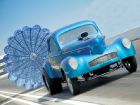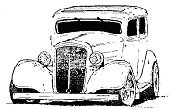| Swindler Redux - 1941 Stone, Woods & Cook Willys
When You Think '60s Drag Racing, Gasser, Or Willys, Only One Car Comes To Mind: The Stone, Woods & Cook Supercharged Willys Gasser. Here's The Story On What Is Widely Considered To Be The Most Famous Drag Race Car Of All Time.
By Matt King
Photography by Matt King, Planet R/Randy Lorentzen, Courtesy Of Mike Cook
Not many cars get featured in HOT ROD multiple times over the span of more than four decades. But the Stone, Woods & Cook Willys is no ordinary car. To many, it's the most famous drag race car in history, even now, nearly 40 years since the last time it ran down a dragstrip in heads-up competition.
To understand why the S-W-C Willys holds such a revered place in hot rodding history, one needs to look at the events that swirled around the sport back in the early part of the '60s, when drag racing and the NHRA were just beginning to gain a national following beyond their roots on the dry lakes of Southern California. The pages of magazines like HOT ROD, Car Craft, and Super Stock, along with weekly tabloid newspapers like Drag News and Drag World, were overflowing with extensive coverage of the men (for the most part) and machines doing regular battle on the match-racing circuit at dragstrips from coast to coast. Their antics were a soap opera followed by hundreds of thousands of racing fans in the days long before ESPN and the Internet.
Barnstorming match-racers like Stone, Woods & Cook, Big John Mazmanian, Junior Thompson, Ohio George Montgomery, the Mallicoat Brothers, and K.S. Pittman entertained thousand of fans at dragstrips all across the country and waged a public relations war in the pages of the tabloid racing press, running ads with pointed headlines, name-calling, and all manner of allegations about on- and off-track racing conspiracies. "When are Pebble, Pulp, and Chef going to stop crying and start racing?" exclaimed one ad in Drag News signed by Junior Thompson. "Big June all shook up over losing the big one to Stone, Woods & Cook," declared another signed by Fred Stone and referring to S-W-C's victory over Big John Mazmanian. Competing camshaft manufacturers joined the fray too, carrying the advertising-driven Cam Wars between companies like Isky and Engle to even higher levels than during the late '50s.
One of the folks at the center of this firestorm was Doug Cook. Born in Little Rock, Arkansas, in 1932, Cook moved to Los Angeles with his family in the late '40s and was soon swept up into the burgeoning post-war hot rodding scene. By the mid '50s, he was driving a '37 Chevy coupe with a supercharged Chevy 265, and later he drove a Willys for Howard Johansen of Howard's Cams. When K.S. Pittman split with the Fred Stone and Tim Woods' team prior to the '61 Indy Nationals, they signed up "Cookie" to drive and wrench on their Swindler II '41 Willys coupe.
There were actually several Swindlers during the period from 1961 to 1966 that Stone, Woods & Cook raced-the original Swindler was Tim Woods' 41 Studebaker with a blown Olds V-8. Swindler II, the first Willys, was initially built to run in the A/Gas class with a bored, stroked, and blown 448ci Olds V-8. It was a show-quality car with blue-and-white tuck-and-roll '58 Thunderbird seats with matching door panels and headliner and a chromed rollbar. The first Swindler II was destroyed in a towing accident returning from the '61 Nationals at Indy and replaced with another virtually identical Willys body. With its familiar light-blue paint, this is the version that gained S-W-C's initial fame, and in 1963, Revell immortalized it by creating a plastic model kit in the Swindler's image. After an NHRA weight-break change in the A/Gas class, the team built a second, lighter Willys in 1964 with a fiberglass front end to take advantage of the new rules. They continued to run the Swindler II in B/Gas, at which time the cars were renamed Swindler A and Swindler B. At first, Swindler A was painted black; both cars were later resprayed in a darker candy blue. After a narrow victory against Big John Mazmanian at the '64 Winternationals, both cars' blown Olds engines were switched to blown Hemis. Swindler B was later traded to fiberglass manufacturer Tex Collins of Cal Automotive for a load of lightweight parts, and the car eventually found its way into the hands of an East Coast street rodder. That car still exists and is currently being restored, according to Doug Cook's son, Mike Cook Sr.
The Swindler A was nearly 1,000 pounds lighter than the Swindler II, with a Spartan black naugahyde interior, a single fiberglass bucket seat, Plexiglas windows, and a bigger 467ci blown Olds. After it was wrecked in a racing accident in 1966, S-W-C built a second Swindler A and continued to run it in A/Gas until 1967, by which time the Gasser Wars were nearing their end. Newer, more aerodynamic body styles were replacing the archaic Gassers, and after a brief effort with an A/Gas '67 Shelby GT350, S-W-C built a '66 Mustang dubbed Dark Horse 2 (the original Dark Horse was the lesser-known '33 Willys campaigned by S-W-C as a third car in the early '60s). Late-model factory experimentals had begun to evolve into early Funny Cars, and Stone, Woods & Cook decided to move on. In 1967, the blown Hemi, Hydro transmission, and all four wheels and tires were removed from the rebuilt Swindler A Willys and transferred to Dark Horse 2 Mustang. Doug Cook was nearly killed driving this car at a race in Alton, Illinois, in September 1967 when it flipped at the top end doing about 180 mph. That crash led to Cookie's retirement from racing.
After it was gutted to build the Mustang, the second Swindler A Willys was ready to be hauled off to the junkyard, according to Mike Cook, who was about 14 at the time. "It was just an old race car, and it was literally on its way to the crusher when I asked if I could have it." The younger Cook, who was too young to drive at the time, had to get permission from his mother to bring the car home. Once he was old enough to drive, Mike drag-raced the Willys with a blown big-block Chevy for several years before he restored it to its Gasser-era configuration in the late '70s.
Following his retirement from driving, Doug Cook split up with Stone and Woods, who campaigned a few Funny Cars with other drivers without much success until about 1974, when they quit racing altogether. Fred Stone passed away in the late '70s and Tim Woods is now retired from his construction business. Ironically, Doug, who died in 1999, later worked on Big John Mazmanian's Barracuda Funny Car, proving that the tabloid-fueled antics were mostly constructed to entertain fans. In his later years, he wrenched on his son Mike's record-holding Bonneville and dry-lakes racers.
Today, Stone, Woods & Cook's legendary Swindler A resides on loan from Mike Cook in the Wally Parks NHRA Motorsports Museum, just a few hundred yards from the famous Pomona dragstrip where it earned so much glory in the heyday of the Gasser Wars. And with T-shirts, die-casts, posters, and other memorabilia still popular among fans young and old, the Swindler's next 40 years could be as successful as its first. |
|
 |







